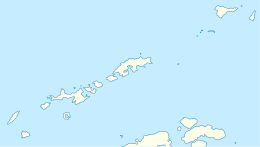 Location of Smith Island in the South Shetland Islands | |
| Geography | |
|---|---|
| Location | Antarctica |
| Coordinates | 62°55′01.6″S 62°32′15″W / 62.917111°S 62.53750°W |
| Archipelago | South Shetland Islands |
| Area | 1.46 ha (3.6 acres) |
| Length | 270 m (890 ft) |
| Width | 90 m (300 ft) |
| Administration | |
| Administered under the Antarctic Treaty | |
| Demographics | |
| Population | uninhabited |

Borda Rock (Bulgarian: скала Борда, romanized: skala Borda, IPA: [skɐˈla borˈda]) is the rock off the NW coast of Smith Island in the South Shetland Islands, Antarctica 270 m long in southwest-northeast direction and 90 m wide (extending 543 by 175 m together with the adjacent minor rocks). Its surface area is 1.46 ha. The vicinity was visited by early 19th century sealers.[1]
The feature is named after Jean-Charles de Borda (1733-1799), a French mathematician, physicist and Navy officer who refined the reflecting circle; in association with other names in the area deriving from the early development or use of geodetic instruments and methods.
Location
[edit]Borda Rock is located at 62°55′01.6″S 62°32′15″W / 62.917111°S 62.53750°W,[2] which is 240 m northwest of Gregory Point. Bulgarian mapping in 2009 and 2017.
See also
[edit]Maps
[edit]- L. Ivanov. Antarctica: Livingston Island and Greenwich, Robert, Snow and Smith Islands. Scale 1:120000 topographic map. Troyan: Manfred Wörner Foundation, 2010. ISBN 978-954-92032-9-5 (First edition 2009. ISBN 978-954-92032-6-4)
- South Shetland Islands: Smith and Low Islands. Scale 1:150000 topographic map No. 13677. British Antarctic Survey, 2009
- L. Ivanov. Antarctica: Livingston Island and Smith Island. Scale 1:100000 topographic map. Manfred Wörner Foundation, 2017. ISBN 978-619-90008-3-0
- Antarctic Digital Database (ADD). Scale 1:250000 topographic map of Antarctica. Scientific Committee on Antarctic Research (SCAR). Since 1993, regularly upgraded and updated
Notes
[edit]- ^ L. Ivanov. General Geography and History of Livingston Island. In: Bulgarian Antarctic Research: A Synthesis. Eds. C. Pimpirev and N. Chipev. Sofia: St. Kliment Ohridski University Press, 2015. pp. 17–28
- ^ Bulgarian Antarctic Gazetteer. Antarctic Place-names Commission
References
[edit]- Bulgarian Antarctic Gazetteer. Antarctic Place-names Commission. (details in Bulgarian, basic data in English)
External links
[edit]- Borda Rock. Adjusted Copernix satellite image
This article includes information from the Antarctic Place-names Commission of Bulgaria which is used with permission.


Well, that’s interesting to know that Psilotum nudum are known as whisk ferns. Psilotum nudum is the commoner species of the two. While the P. flaccidum is a rare species and is found in the tropical islands. Both the species are usually epiphytic in habit and grow upon tree ferns. These species may also be terrestrial and grow in humus or in the crevices of the rocks.
View the detailed Guide of Psilotum nudum: Detailed Study Of Psilotum Nudum (Whisk Fern), Classification, Anatomy, Reproduction